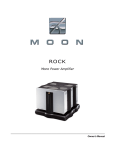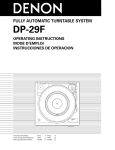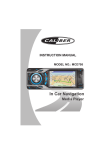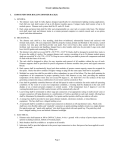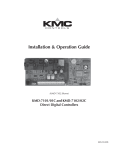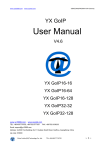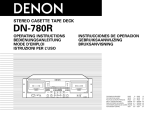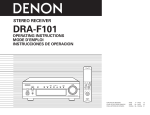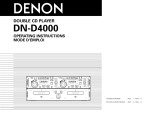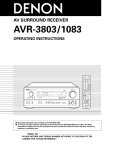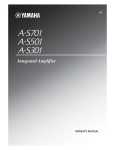Download Denon PMA-2000IVR Stereo Amplifier User Manual
Transcript
INTEGRATED STEREO AMPLIFIER PMA-2000IVR OPERATING INSTRUCTIONS B VOLUME MUTE/STANDBY INPUT SELECTOR TAPE-2/MD TAPE-1/CD-R PHONO CD TUNER DVD/AUX-1 AUX-2/P. DIRECT POWER SOURCE DIRECT ¢ ON/STANDBY £ OFF ¢ ON £ OFF REMOTE SENSOR BASS TREBLE REC OUT SELECTOR BALANCE CD PHONO PHONES TAPE-11 2 COPY AMP TUNER AUX-1 POWER MUTING 9 AUX-2 8 TRACK LEFT FUNCTION VOLUME RIGHT 3 2 1 PAUSE STOP PLAY CD B REMOTE CONTROL UNIT RC-858 “SERIAL NO. PLEASE RECORD UNIT SERIAL NUMBER ATTACHED TO THE REAR OF THE CABINET FOR FUTURE REFERENCE” 2 SAFETY PRECAUTIONS CAUTION CAUTION TO PREVENT ELECTRIC SHOCK, MATCH WIDE BLADE OF PLUG TO WIDE SLOT, FULLY INSERT. RISK OF ELECTRIC SHOCK DO NOT OPEN CAUTION: TO REDUCE THE RISK OF ELECTRIC SHOCK, DO NOT REMOVE COVER (OR BACK). NO USER-SERVICEABLE PARTS INSIDE. REFER SERVICING TO QUALIFIED SERVICE PERSONNEL. The lightning flash with arrowhead symbol, within an equilateral triangle, is intended to alert the user to the presence of uninsulated “dangerous voltage” within the product’s enclosure that may be of sufficient magnitude to constitute a risk of electric shock to persons. The exclamation point within an equilateral triangle is intended to alert the user to the presence of important operating and maintenance (servicing) instructions in the literature accompanying the appliance. WARNING: TO REDUCE THE RISK OF FIRE OR ELECTRIC SHOCK, DO NOT EXPOSE THIS APPLIANCE TO RAIN OR MOISTURE. ATTENTION POUR ÉVITER LES CHOCS ÉLECTRIQUES, INTERODUIRE LA LAME LA PLUS LARGE DE LA FICHE DANS LA BORNE CORRESPONDANTE DE LA PRISE ET POUSSER JUSQU’ AU FOND. This device complies with Part 15 of the FCC Rules. Operation is subject to the following two conditions: (1) This device may not cause harmful interference, and (2) this device must accept any interference received, including interference that may cause undesired operation. This Class B digital apparatus meets all requirements of the Canadian Interference-Causing Equipment Regulations. Cet appareil numérique de la classe B respecte toutes les exigences du Règlement sur le matériel brouilleur du Canada. 2 NOTE ON USE • Do not let foreign objects in the set. • Keep the set free from moisture, water, and dust. • Avoid high temperatures. Allow for sufficient heat dispersion when installed on a rack. • Unplug the power cord when not using the set for long periods of time. • Handle the power cord carefully. Hold the plug when unplugging the cord. * (For sets with ventilation holes) • Do not obstruct the ventilation holes. 2 • Do not let insecticides, benzene, and thinner come in contact with the set. • Never disassemble or modify the set in any way. SAFETY INSTRUCTIONS 1. 2. 3. 4. 5. 6. 7. 8. 9. 10. 11. 12. Read Instructions – All the safety and operating instructions should be read before the product is operated. Retain Instructions – The safety and operating instructions should be retained for future reference. Heed Warnings – All warnings on the product and in the operating instructions should be adhered to. Follow Instructions – All operating and use instructions should be followed. Cleaning – Unplug this product from the wall outlet before cleaning. Do not use liquid cleaners or aerosol cleaners. Attachments – Do not use attachments not recommended by the product manufacturer as they may cause hazards. Water and Moisture – Do not use this product near water – for example, near a bath tub, wash bowl, kitchen sink, or laundry tub; in a wet basement; or near a swimming pool; and the like. Accessories – Do not place this product on an unstable cart, stand, tripod, bracket, or table. The product may fall, causing serious injury to a child or adult, and serious damage to the product. Use only with a cart, stand, tripod, bracket, or table recommended by the manufacturer, or sold with the product. Any mounting of the product should follow the manufacturer’s instructions, and should use a mounting accessory recommended by the manufacturer. A product and cart combination should be moved with care. Quick stops, excessive force, and uneven surfaces may cause the product and cart combination to overturn. Ventilation – Slots and openings in the cabinet are provided for ventilation and to ensure reliable operation of the product and to protect it from overheating, and these openings must not be blocked or covered. The openings should never be blocked by placing the product on a bed, sofa, rug, or other similar surface. This product should not be placed in a built-in installation such as a bookcase or rack unless proper ventilation is provided or the manufacturer’s instructions have been adhered to. Power Sources – This product should be operated only from the type of power source indicated on the marking label. If you are not sure of the type of power supply to your home, consult your product dealer or local power company. For products intended to operate from battery power, or other sources, refer to the operating instructions. Grounding or Polarization – This product may be equipped with a polarized alternating-current line plug (a plug having one blade wider than the other). This plug will fit into the power outlet only one way. This is a safety feature. If you are unable to insert the plug fully into the outlet, try reversing the plug. If the plug should still fail to fit, contact your electrician to replace your obsolete outlet. Do not defeat the safety purpose of the FIGURE A EXAMPLE OF ANTENNA GROUNDING AS PER NATIONAL ELECTRICAL CODE ANTENNA LEAD IN WIRE 13. 15. 16. 17. 18. 19. 20. 21. 22. 23. GROUND CLAMP ANTENNA DISCHARGE UNIT (NEC SECTION 810-20) ELECTRIC SERVICE EQUIPMENT 24. 25. GROUNDING CONDUCTORS (NEC SECTION 810-21) GROUND CLAMPS Power-Cord Protection – Power-supply cords should be routed so that they are not likely to be walked on or pinched by items placed upon or against them, paying particular attention to cords at plugs, convenience receptacles, and the point where they exit from the product. Outdoor Antenna Grounding – If an outside antenna or cable system is connected to the product, be sure the antenna or cable system is grounded so as to provide some protection against voltage surges and built-up static charges. Article 810 of the National Electrical Code, ANSI/NFPA 70, provides information with regard to proper grounding of the mast and supporting structure, grounding of the lead-in wire to an antenna discharge unit, size of grounding conductors, location of antenna-discharge unit, connection to grounding electrodes, and requirements for the grounding electrode. See Figure A. Lightning – For added protection for this product during a lightning storm, or when it is left unattended and unused for long periods of time, unplug it from the wall outlet and disconnect the antenna or cable system. This will prevent damage to the product due to lightning and power-line surges. Power Lines – An outside antenna system should not be located in the vicinity of overhead power lines or other electric light or power circuits, or where it can fall into such power lines or circuits. When installing an outside antenna system, extreme care should be taken to keep from touching such power lines or circuits as contact with them might be fatal. Overloading – Do not overload wall outlets, extension cords, or integral convenience receptacles as this can result in a risk of fire or electric shock. Object and Liquid Entry – Never push objects of any kind into this product through openings as they may touch dangerous voltage points or short-out parts that could result in a fire or electric shock. Never spill liquid of any kind on the product. Servicing – Do not attempt to service this product yourself as opening or removing covers may expose you to dangerous voltage or other hazards. Refer all servicing to qualified service personnel. Damage Requiring Service – Unplug this product from the wall outlet and refer servicing to qualified service personnel under the following conditions: a) When the power-supply cord or plug is damaged, b) If liquid has been spilled, or objects have fallen into the product, c) If the product has been exposed to rain or water, d) If the product does not operate normally by following the operating instructions. Adjust only those controls that are covered by the operating instructions as an improper adjustment of other controls may result in damage and will often require extensive work by a qualified technician to restore the product to its normal operation, e) If the product has been dropped or damaged in any way, and f) When the product exhibits a distinct change in performance – this indicates a need for service. Replacement Parts – When replacement parts are required, be sure the service technician has used replacement parts specified by the manufacturer or have the same characteristics as the original part. Unauthorized substitutions may result in fire, electric shock, or other hazards. Safety Check – Upon completion of any service or repairs to this product, ask the service technician to perform safety checks to determine that the product is in proper operating condition. Wall or Ceiling Mounting – The product should be mounted to a wall or ceiling only as recommended by the manufacturer. Heat – The product should be situated away from heat sources such as radiators, heat registers, stoves, or other products (including amplifiers) that produce heat. POWER SERVICE GROUNDING ELECTRODE SYSTEM (NEC ART 250, PART H) NEC - NATIONAL ELECTRICAL CODE 3 NOTE: 1. Always keep the POWER switch on the main unit turned on. 2. Turn the power on and off from the remote control unit. 3. Unplug the power cord when you do not plan to use the unit for a long period of time. PRECAUTIONS FOR INSTALLATION For heat dispersal, leave at least 10 cm of space between the top, back and sides of this unit and the wall or other components. ✽ 10cm or more CAUTION: If only the MUTE/STANDBY LED is lit red, this means that the power is turned off from the remote control unit. Turn the power on from the remote control unit. ✽ B ✽ — TABLE OF CONTENTS — z DESIGNATIONS AND FUNCTIONS OF PANEL CONTROLS …………………………4 ~ 7 x c v b n CONNECTIONS ✽ …………………………………………………7, 8 OPERATION …………………………………………………………9 ✽ REMOTE CONTROL OPERATION ……………………………10, 11 TROUBLESHOOTING ………………………………………………12 SPECIFICATIONS ……………………………………………………13 Please check to make sure the following items are included with the main unit in the carton: Wall (1) Operating Instructions ………………………………………………1 (2) Warranty ………………………………………………………………1 (3) Remote Control Unit (RC-858) ………………………………………1 (4) Batteries R03 (AAA) …………………………………………………2 (5) Power Supply Cord ……………………………………………………1 (6) Service Station List ……………………………………………………1 1 DESIGNATIONS AND FUNCTIONS OF PANEL CONTROLS Front Panel !1 !0 B VOLUME MUTE/STANDBY INPUT SELECTOR TAPE-2/MD TAPE-1/CD-R PHONO CD POWER SOURCE DIRECT ¢ ON/STANDBY £ OFF ¢ ON £ OFF REMOTE SENSOR BASS TREBLE REC OUT SELECTOR BALANCE CD PHONO TUNER PHONES AUX-1 TAPE-11 2 AUX-2 COPY RIGHT LEFT qw e 4 r t y u i o TUNER DVD/AUX-1 AUX-2/P. DIRECT q w r t y u i • AUX-1: Used to recording component that connected to the DVD/ AUX-1 terminals. • AUX-2: Used to recording component that connected to the AUX2 terminals. Remote Control Sensor (REMOTE SENSOR) This sensor receives the infra-red light transmitted from the wireless remote control unit. For remote control, point the wireless remote control unit towards the sensor. e • TUNER: Used to recording from the tuner. Power switch (POWER) When the power switch is turned ON ( ¢ ), the MUTE/STANDBY LED !1 lights. When the power switch is turned ON, power is supplied to the unit. It takes a few seconds after the power is turned on for the unit to warm up. This is due to the built-in muting circuit that eliminates noise during the on/off operation. NOTE: Copying is not possible from TAPE-2/MD to TAPE1/CD-R. o Headphone jack (PHONES) This jack is used to plug in the headphones. (The SPEAKER output is turned off when the headphones are plugged in.) To prevent hearing loss, do not raise the volume level excessively when using headphones. • TAPE-1/CD-R: Use this position when using the tape deck, etc., connected to the TAPE-1/CD-R terminals. This knob is used to control the bass quality of the sound. When the knob is set at the center position, the frequency characteristics are flattened in the range below 1000 Hz. The bass is emphasized as the knob is moved off center to the right (,), and reduced as it is moved to the left (.). • PHONO: Use this position when using the record player connected to the PHONO terminals. Use the CARTRIDGE selection switch @1 to switch the sensitivity to correspond to the cartridge type being used. Treble control (TREBLE) This knob is used to control the treble quality of the sound. When the knob is set at the center position, the frequency characteristics are flattened in the range above 1000 Hz. The treble is emphasized as the knob is moved off center to the right (,), and reduced as it is moved to the left (.). • CD: Used to listen a compact disc player or other component that is connected to the CD terminals. • TUNER: Used to play a component such as an FM/AM tuner or a TV tuner that is connected to the TUNER terminals. Balance control (BALANCE) This knob is used to adjust the balance between the left and right channels. When it is set to the center position, the amplitude of the amplifier is equal on both sides. If the volume on the right side is too low, turn the knob to the right (,). If the volume on the left side is too low, turn the knob to the left (.). This will achieve an even balance on the left and right sides. • DVD/AUX-1: Used to play a component such as a HiFi video player, TV tuner or tape deck that is connected to the DVD/AUX-1 terminals. • AUX-2/P. DIRECT: Used to play a component such as a HiFi video player, TV tuner or tape deck that is connected to the AUX-2 terminals. And power amp direct terminal is selected by using the P. DIRECT switch on the back panel. Volume control (VOLUME) This knob controls the overall volume level. Turn the knob to the right (,) to raise the volume and to the left (.) to lower it. NOTE: When selecting the power amp direct terminal, volume control function of this unit does not work, so set volume level by the component connecting to this terminal. Recording output selector (REC OUT SELECTOR) • TAPE-1 1 2: (COPY) Use this position when making copies of tapes using two tape decks. The input signal from the deck connected to the TAPE-1/CD-R input terminals is fed to the TAPE-2/MD REC OUT terminals. • PHONO: Used to recording from the turntable. • CD: Used to recording from the CD player. Use these to select the program source. When the switch for the desired program source is selected, its LED lights. One program source only can be selected at a time, as follows. • TAPE-2/MD: Use this position when using the tape deck, etc., connected to the TAPE-2/MD terminals. Bass control (BASS) Use this to select the output source for recording onto a tape deck, etc. Input selector switch (INPUT SELECTOR) !0 !1 Source direct switch (SOURCE DIRECT) The controls (BASS r, TREBLE t and BALANCE y) can be used when this switch is in the OFF (£) position. When set to the ON (¢) position, the above controls are by passed and the signals are input directly to the volume control circuit, providing high quality sound. Mute/Standby LED (MUTE/STANDBY) This LED flashes while the muting circuit is activated when the power is turned on and when muting is turned on from the remote control unit, and remains lit (without flashing) while the power switch q is turned ON (¢). 5 Rear Panel @1 !2 !3 !2 @0 !4 !5 !9 !6 Inputs terminals (INPUTS) These are input terminals for CD players, turntables, AM/FM tuners, tape decks or other playback components. !7 !6 NOTE: The PHONO input terminals are equipped with a short pin-plug. Remove this plug to connect a record player. Store the removed short pin-plug in a safe place so as not to lose it. !3 Playing and recording input/output terminals (TAPE-1/CD-R, TAPE-2/MD) Power amp direct terminals (POWER AMP DIRECT) Souurce connected to this terminal is directly fed to the power amp. set volume level by the component connected to this terminal. !5 Power amp direct switch (POWER AMP DIRECT) ON position: Power amp direct terminal is selected when INPUT SELECTOR is set to AUX-2/P. DIRECT position. OFF position: AUX-2 is selected when INPUT SELECTOR is set to AUX2/P. DIRECT position. Pre out terminals (PRE OUT) Use these when adding a power amplifier, a subwoofer with built-in power amplifier, etc. Connect these PRE OUT terminals to the input terminals on the additional power amplifier, subwoofer, etc. NOTE: Signals are outputted from the PRE OUT terminals even when using headphones. No signal is outputted when selecting power amp direct terminal (see o, page 5) !7 These are playing and recording input/output terminals for connection to tape decks. !4 !8 Speaker systems terminals (SPEAKER SYSTEMS) Connect the speaker systems here. !8 !9 AC inlet receptacle (AC IN) Connect the included power supply cord here. Do not use any other cord than the provided power supply cord. Attachment plug receptacles (AC OUTLETS) AC outlets are used for connecting amplifier component units, such as tuner, turntable, tape deck, etc. • SWITCHED (Total capacity: 120 W / 1 A): These outlets are turned ON/OFF when main power switch is turned on/off. • UNSWITCHED (Capacity: 240 W / 2 A): This outlet is always ON whether power switch is on or off. NOTE: This equippment may be different according to the country. 6 @0 Ground terminal (SIGNAL GND) Connect the turntable’s ground wire here. NOTE: This terminal is used to reduce noise when a turntable, etc., is connected. It does not provide grounding. @1 Cartridge selection switch (CARTRIDGE) This switch is set according to the type of player cartridge to be used. Set this switch to MM (£) or MC (¢) according to the type of cartridge used on your turntable. 2 CONNECTIONS Connecting the speakers • Speaker impedance • When using speaker systems A and B separately, speakers with an impedance of 4 to 16 Ω/ohms can be connected. • When biwiring with biwireable speaker system, speakers with an impedance of 4 to 16 Ω/ohms can be connected. • Note that when using two sets of speaker systems together (A + B), use speakers with impedance 8 to 16 Ω/ohms, using speakers with an impedance other than between 8 to 16 Ω/ohms may cause damages. Note that this unit is not equipped with a switch for selecting the speaker system. The A and B speaker output terminals are connected in parallel. • The protective circuit may be activated if speakers with other impedances are connected. • Be sure to connect the cords between the speaker terminals and speaker systems with the same polarities (< to <, > to >). If not, the central sound will be weak and the position of the different instruments will not be clear, diminishing the stereo effect. • When connecting the speakers, be sure that the core wires of the speaker cords do not stick out from the terminals and touch other terminals, each other or the rear panel. • Connecting the speaker cords q Peel off the sheathing from the end of the cord. w Twist the core wires. e Turn the speaker terminal counterclockwise to loosen it. r Insert the core wires entirely, then turn the terminal clockwise to tighten it. CAUTION Protective Circuit This set is equipped with a high speed protective circuit. This circuit protects the internal circuitry from damage due to large currents flowing when the speaker jacks are not completely connected or when an output is generated by a short circuit. This protective circuit’s operation cuts off the output to the speakers. In such a case, be sure to turn the power off and check the connections to the speakers. Then turn the power on again. After muting for several seconds, the set will operate normally. NOTE: NEVER touch the speaker terminals when the power is on. Doing so could result in electric shocks. 7 Cautions on Connections • Do not plug in the power cord until all connections are completed. • Be sure to connect the left and right channels properly. • Insert the plugs securely. Incomplete connections can result in noise. • Use the SWITCHED AC OUTLETS to plug in audio components. Do not use them for hair dryers or other appliances. DVD player (sound only) • Note that placing the pin plug cords next to power supply cords or near power transformers may result in humming or other noise. • The PHONO input jacks have an extremely high sensitivity, so avoid turning up the volume when no pin plug cords are connected. Doing so may result in induction humming (booming) from the speakers. When pin plug cords are not connected, insert the included short-circuit pin plug. DVD player (sound only) B B Tuner SPEAKER SYSTEM (A) SPEAKER SYSTEM (B) Turntable (for MC, MM) LINE OUT CD player Ground wire ✽ Connect the ground wire, but disconnect it if humming or other noise is generated. L R L LINE OUT LINE OUT LINE OUT Subwoofer Power supply cord LINE OUT (PB) PRE OUT AV Center Power amplifier Tape deck or MD recorder LINE IN (REC) Tape deck or CD-R LINE IN (REC) LINE OUT (PB) 8 LINE IN LINE IN B HIGH HIGH LOW LOW R L SPEAKER SYSTEM (BI-WIRING) When bi-wiring with bi-wireable speakers, connect the mid and high range terminals to SYSTEM (A) (or SYSTEM (B)), the low range terminals to SYSTEM (B) (or SYSTEM (A)). R 3 OPERATION (Refer to page 4 and 6) PREPARATION 1. CHECKING CONNECTIONS • Make sure that all the connections are proper by referring to the rear panel. • Check the polarity (positive and negative) of connections, and the directivity of stereo separation (right cord to right channel terminal, and left cord to left channel terminal). • Check the directivity of pin cord connection. 2. SETTING OF EACH KNOB • Turn the volume control knob u counterclockwise, to minimum position. • Set the rotary knob r, t, y to center position. • Set SOURCE DIRECT !0 to “OFF (£)”. After checking the above items, turn on the power, the amplifier is set in the ready mode in a few seconds. PLAYING A RECORD 1. Set the CARTRIDGE selection switch @1 “MC (¢)” or “MM (£)”. 2. Set the INPUT SELECTOR switch o to “PHONO”. 3. Operate the turntable and play the record. 4. Turn the volume u and tone controls r, t, y to yield an appropriate volume and sound quality. PLAYING CD PLAYER 1. Set the INPUT SELECTOR switch o to “CD”. 2. Operate the CD player. 3. Turn the volume u and tone controls r, t, y to yield an appropriate volume and sound quality. RECEPTION OF RADIO PROGRAMS 1. Set the INPUT SELECTOR switch o to “TUNER”. 2. Operate the tuner to receive a radio program. 3. Turn the volume u and tone controls r, t, y to yield an appropriate volume and sound quality. RECORDING WITH TAPE DECK 1. Set the REC OUT SELECTOR switch i to the program source you wish to record. 2. Play back the program source. 3. Start recording with the component connected to “TAPE1/CD-R” or “TAPE-2/MD”. • In the PMA-2000IVR, the REC OUT signal and the speaker (headphone) signal are output via separate circuits so that knobs and switches related to the tone and volume have no effect what ever on the sound that is recorded. Also, since the recording function is selected by the REC OUT SELECTOR switch i, the free program source can be played through the speakers (or headphones) even during recording. • MONITORING THE RECORDING A recording in progress can be monitored if a tape deck with three individual heads for recording and playback is used. A tape deck in which a common head is used for both recording and playback cannot be used to monitor recording. When a recording is being made using TAPE-1/CD-R, selecting TAPE1/CD-R with the INPUT SELECTOR will engage the RECORDING MONITOR and pemit a check of the recording condition. COPYING FROM ONE TAPE TO ANOTHER To copy from TAPE-1/CD-R to TAPE-2/MD, set the REC OUT SELECTOR switch i to “TAPE-1 1 2”. NOTE: Copying is not possible from TAPE-2/MD to TAPE-1/CD-R. NOTE: • This amplifier has a full memory back-up system. When the power is turned on, INPUT SELECTOR o are set to the last mode set before the power was turned off. PLAYING AUDIO EQUIPMENT CONNECTED TO AUX TERMINALS 1. Set the INPUT SELECTOR switch o to “DVD/AUX-1” (AUX-2/ P. DIRECT) position. 2. Operate the Audio equipment Systems. 3. Turn the volume u and tone controls r, t, y to yield an appropriate volume and sound quality. NOTE: If power amp direct switch (BACK PANEL) is set to ON position, power amp direct terminal is selected when AUX2/P. DIRECT is selected. (see o, page 5) PLAY BACK WITH TAPE DECK 1. Set the INPUT SELECTOR switch o to “TAPE-1/CD-R” or “TAPE-2/MD”. 2. Operate the Tape Deck. 3. Turn the volume u and tone controls r, t, y to yield an appropriate volume and sound quality. 9 4 REMOTE CONTROL OPERATION The accessory Remote Control Unit is used to control the amplifier from a convenient distance. (1) Inserting the Dry Cell Batteries 1. Remove the battery cover on the Remote Control Unit. 2. Insert two dry cell batteries as shown in the diagram on the battery supply unit. 3. Replace the battery cover. Notes on Battery Usage • RC-858 uses the size R03 (AAA) dry cell batteries. • The batteries will need to be replaced approximately once a year. This will depend upon how often the Remote Control Unit is used. • If, in less than a year from the time new batteries were inserted, the Remote Control Unit fails to operate the Amplifier from a near-by position, it is time to replace the batteries. (The included battery is only for verifying operation. Replace it with a new battery as soon as possible.) • Insert the batteries properly, following the polarity diagram inside the battery compartment. • Batteries are prone to damage and leakage. Therefore: • Do not mix new batteries with used ones. • Do not mix different types of batteries. • Do not jumper opposite poles of the batteries, expose them to heat, break them open, nor expose them to open fire. • If the batteries have leaked, remove any traces of battery fluid from the battery compartment wiping thoroughly with a dry cloth. Then insert new batteries. (2) Directions for use • Operate the Remote Control Unit while pointing it towards the Remote Control Sensor on the Amplifier as shown in the diagram on the left. • The Remote Control Unit can be used at distances up to about 8 meters in a straight line from the amplifier. This distance will decrease if there are obstructions blocking the infra-red light transmission or if the Remote Control Unit is not directed straight at the amplifier. 30° 30° Approx. 8 meters Note on operation • Do not press the operating buttons on the Amplifier and the Remote Control Unit at the same time. This will cause misoperation. • Operation of the Remote Control Unit will become less effective or erratic if the infrared Remote Control Sensor on the Amplifier is exposed to strong light or if there are obstructions between the Remote Control Unit and the sensor. • In case you operate a VCR, TV or other components by remote control, do not operate buttons on two different remote control units at the same time. This will cause misoperation. Besides being able to operate the PMA-2000 IVR Integrated-amplifier with this Remote Control Unit, you can also operate a DENON CD player from this handy Remote Control Unit. 10 Remote Control Unit RC-858 supplied with the PMA-2000IVR Pre-main Amplifier Block Use these to control the PMA-2000IVR. MUTING : When pressed, the main unit’s power LED flashes and the speaker output is turned off. When pressed again, the mute mode is canceled and the power LED stops flashing (remaining lit). AMP POWER MUTING 9 8 TRACK FUNCTION VOLUME 3 2 1 PAUSE STOP PLAY CD B REMOTE CONTROL UNIT RC-858 CD player Block Use these to control the CD player connected to the PMA-2000IVR. 1 PLAY : Playback 2 STOP : Stop 3 PAUSE : Pause 8 : Auto search (to beginning of track) 9 : Auto search (to beginning of track) NOTE: With DENON portable CD players and some other CD players, the auto search mode is set when the 8 or 9 button is pressed shortly then released, and the manual search mode is set when one of the buttons is held in. POWER : • When the main unit’s power switch is set to the ON/STANDBY position (¢), press this to turn the PMA-2000IVR’s power on and off. • When the power is turned off from the remote control unit, the main unit’s power LED remains lit, but the input LED turns off, indicating that the PMA2000IVR is in the standby mode. • When the main unit’s power button is set to the OFF position (£) after turning the power off from the remote control unit and then set back to the ON/STANDBY position (¢), the PMA-2000IVR is set to the operating mode. VOLUME • UP : While this is pressed, the main unit’s volume control turns clockwise and the volume increases. VOLUME ª DOWN : While this is pressed, the main unit’s volume control turns counterclockwise and the volume decreases. FUNCTION • : Use this to select the program source to be played. The function switches in the following order each time this is pressed: CD / TUNER / DVD/AUX-1 / AUX-2/ P. DIRECT / TAPE-2/MD / TAPE-1/CD-R / PHONO / CD FUNCTION ª : Use this to select the program source to be played. The function switches in the following order each time this is pressed: CD / PHONO / TAPE-1/CD-R / TAPE2/MD / AUX-2/P. DIRECT / DVD/AUX-1 / TUNER / CD • The RC-858 Remote Control Unit can control CD players manufactured by DENON. • Note that operation may not be possible for some models. CAUTION: Some of the functions of the PMA-2000IVR can also be controlled with the remote control units included with other DENON premain amplifiers. 11 5 TROUBLESHOOTING Check the following before assuming there is a problem with the set. 1. Are all connections proper ? 2. Is the set being operated as described in the operating instructions ? 3. Are the speakers and input components being operated properly ? If the set does not seem to be operating properly, check the points listed below. If these points do not apply, the set may be damaged. Turn off the power immediately and contact your store of purchase. Remote control unit. Problems occurring when playing records. Common problems arising when listening to the CD, records, tapes, and FM broadcasts, etc. Symptom 12 MUTE/STANDBY LED does not light and no sound is produced when POWER switch is turned on. Cause Measures Page • Power supply cord is not connected. • Check that the cord is plugged in. • Speaker cords not properly connected. • INPUT SELECTOR is not set to proper position. • VOLUME control turned down. • Connect securely. 7, 8 • Set to the proper position. 5, 9 • Set to an appropriate level. 5, 9 • Speaker cords not properly connected. • Input cords not are properly connected. • Left/right balance improperly adjusted. • Connect securely. 7, 8 • Connect securely. • Adjust the BALANCE control. 8 5, 9 • Tuner or record output is different. • Adjust the tuner output to the turntable’s output (if the tuner is equipped with an output control). – Positions of instruments inverted for stereo sources. • Left and right speakers or input cords the inverted. • Check the left/right connections. 7, 8 • Connect securely. 8 Booming sound produced when playing records. • Turntable’s ground wire is not connected. • Input cords are not properly connected to PHONO terminals. • Influence from a TV or VCR near the turntable. • Connect securely. 8 • Change the position of installation. – • Turntable and speaker systems are too close. • Floor is soft and vibrates easily. • Move speaker systems as far away as possible. • Use cushions to absorb the vibrations transmitted from the floor to the speakers. If the turntable does not include insulators, use audio insulators, available in stores. – Sound is distorted. • Stylus pressure is too light. • Dirt on tip of stylus. • Defective cartridge. • Apply proper pressure. • Check the tip of the stylus. • Replace the cartridge. – – – • Replace with new batteries. • Move closer. 10 10 This unit is not operated properly when remote control unit is used. • Batteries are dead. • Remote control unit is too far from this unit. • Obstacle between this unit and remote control unit. • Different button is being pressed. • < and > ends of battery is inserted in reverse. • Remove obstacle. 10 • Press the proper button. • Insert batteries properly. 11 10 MUTE/STANDBY LED lights but no sound is produced. Sound is not produced from one side only. Volume level is different when listening to tuner and records. Howling produced when volume is turned up while playing records. 8 – 6 SPECIFICATIONS • POWER AMPLIFIER SECTION Rated Output Power: Both channel driven (8 Ω/ohms Load) 80 W + 80 W 20 Hz to 20 kHz, T.H.D. 0.07 % (4 Ω/ohms Load) 160 W + 160 W DIN, 1 kHz, T.H.D. 0.7 % Total Harmonic Distortion: 0.01 % (–3 dB at rated output, 8 Ω/ohms) (1 kHz) Input Sensitivity/Input Impedance: P. DIRECT: 0.9 V/47 kΩ/kohms Amplification factor: 29 dB • PRE AMPLIFIER SECTION PHONO EQUALIZER Rated Output: 150 mV (Recout Terminal) Input Sensitivity/Input Impedance: The value in parentheses ( ) refers to the input impedance when SOURCE DIRECT is ON. PHONO: MM: 2.5 mV/47 kΩ/kohms MC: 200 µV/100 Ω/ohms CD, TUNER, DVD/AUX-1, 135 mV/47 kΩ/kohms AUX-2, TAPE-1/CD-R, (135 mV/12 kΩ/kohms) TAPE-2/MD RIAA Deviation: PHONO: 20 Hz ~ 20 kHz ±0.5 dB Maximum Input: PHONO MM: 130 mV/1 kHz MC: 10 mV/1 kHz Rated Output: PRE PUT: 0.9 V (Input CD 135 mV) • OVERALL CHARACTERISTICS SN Ratio (IHF A Network): PHONO (input terminals shortcircuited) MM: 89 dB (at 5 mV input) (input terminals shortcircuited) MC: 74 dB (at 0.5 mV input) SOURCE-DIRECT: ON CD, TUNER, DVD/AUX-1, AUX-2, TAPE-1/CD-R, TAPE-2/MD: 108 dB Tone Control Adjustable Range: BASS: 100 Hz ±8 dB TREBLE: 10 kHz ±8 dB • OTHERS Power Supply: AC Outlets: Switched x 2: Unswitched x 1: Power Consumption: Dimensions: Net Mass: AC 120 V, 60 Hz 1 A / 120 W (Total) 2 A / 240 W 6.0 A 434 (W) x 180 (H) x 478 (D) mm (17-3/32” x 7-5/64” x 18-13/16”) 24.0 kg (52 lbs 14.7 oz) • REMOTE CONTROL UNIT (RC-858) Remote control system: Infrared pulse system Power supply: 3 V DC, Two size R03 (AAA) dry cell batteries External dimensions: 56 (W) x 105 (H) x 19 (D) mm (2-3/16” x 4-1/8” x 23/32”) Mass: 70 g (Approx. 2.47 oz) (including batteries) ✽ Maximum dimensions include controls, jacks, and covers. (W) = width, (H) = height, (D) = depth • For improvement purposes, specifications and functions are subject to change without advanced notice. 13 MEMO 14 MEMO 15 16-11, YUSHIMA 3-CHOME, BUNKYOU-KU, TOKYO 113-0034, JAPAN Telephone: (03) 3837-5321 Printed in Japan 511 3917 001
















